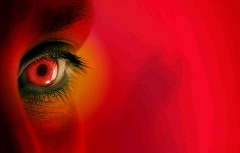A magazine where the digital world meets the real world.
On the web
- Home
- Browse by date
- Browse by topic
- Enter the maze
- Follow our blog
- Follow us on Twitter
- Resources for teachers
- Subscribe
In print
What is cs4fn?
- About us
- Contact us
- Partners
- Privacy and cookies
- Copyright and contributions
- Links to other fun sites
- Complete our questionnaire, give us feedback
Search:
Sensational - the try 'em at home guide to illusions
Your adaptable senses: Looking at your eyes' wiring

Scientists often work out a theory in one area and find it also applies in another. Our senses are a good example of this. They all have the same sorts of characteristics and adaptation is one of the ones that is common across the senses.
In vision, for example, it's been shown that if you use special contact lenses that cause an image to fall on exactly the same part of the retina (the light sensitive part at the back of your eye) as you move your eye, that image will vanish. The light sensitive cells in the retina adapt to the image on them. In effect it's there for too long and the vision system ends up ignoring it, waiting for something interesting to come along. That is why your eyes make thousands of tiny involuntary movements called saccades every second, so that the image on the retina is always changing. This kind of eye movement can also be used in computer vision systems to help improve their accuracy, by building up the information needed to recognise objects, for example.
You may have seen the above one for yourself. Perhaps one of the most 'geee I'm a biological machine' moments you could have is when you see your wiring. The retina needs lots of energy to measure the light in your eye. To do this it needs blood, biology's way of carrying nutrients. The surface of your retina is covered with a web of blood capillaries, but you don't see them. Why? Because they are static on your retina, so your visual system adapts them way. From time to time, when you wake up and the early morning sunlight comes in at an angle you can briefly see a dense tree of these capillaries, as the light at an angle casts a shadow that the visual system wasn't expecting and didn't adapt to. If you're very careful you can use a torch at an angle to create this effect. When you get it right it's amazing. You can see the wiring on your retina, all be it briefly. It's quite a sensational experience.


